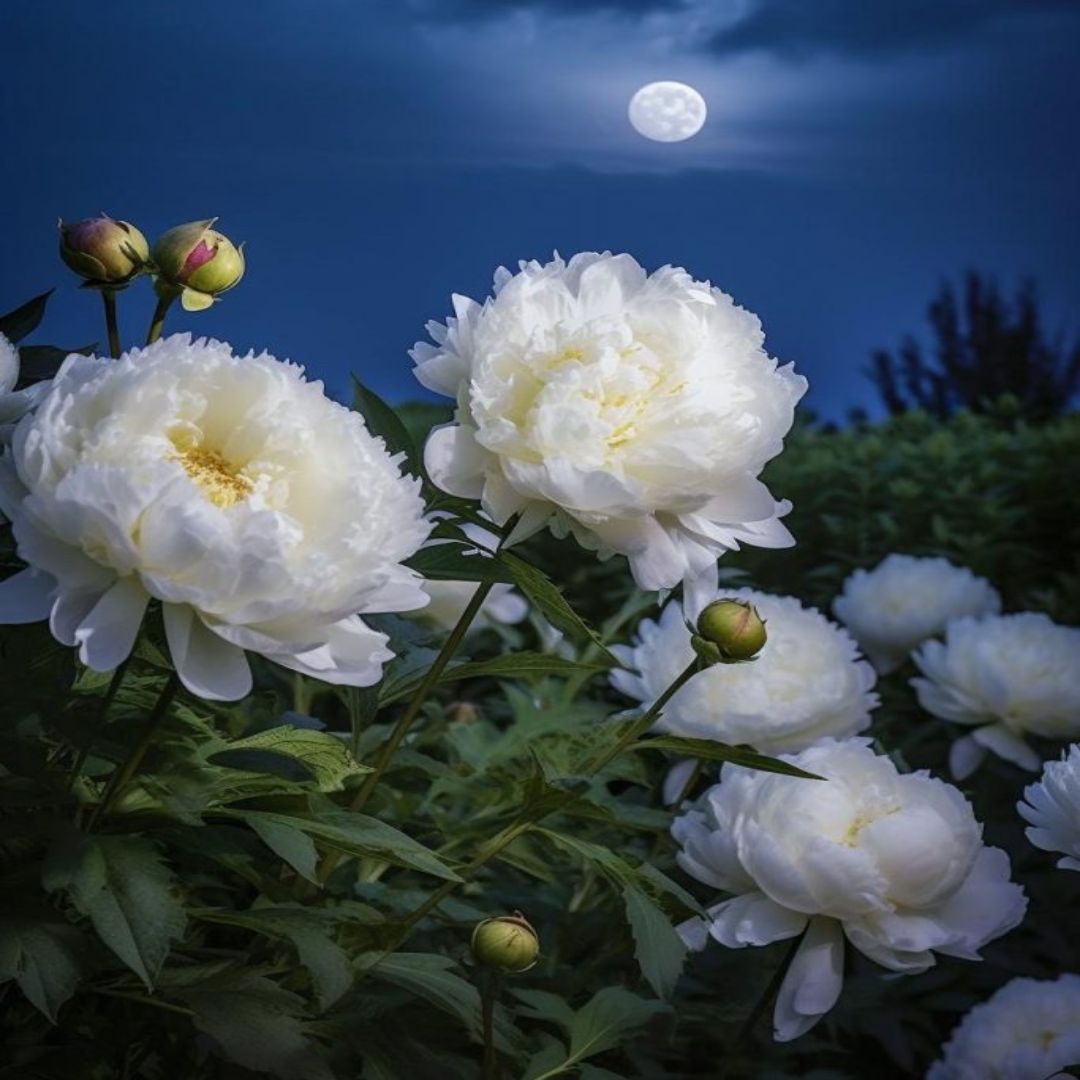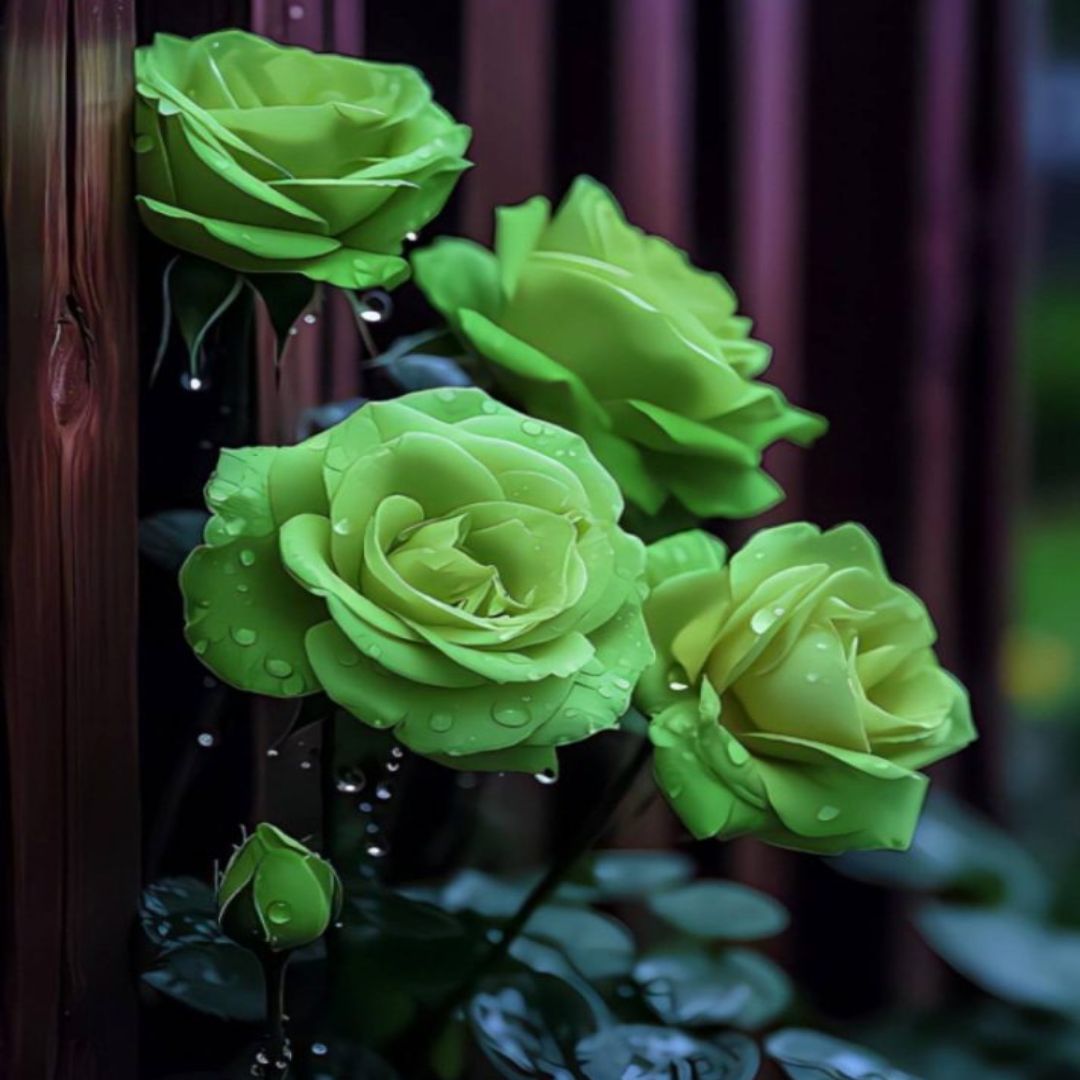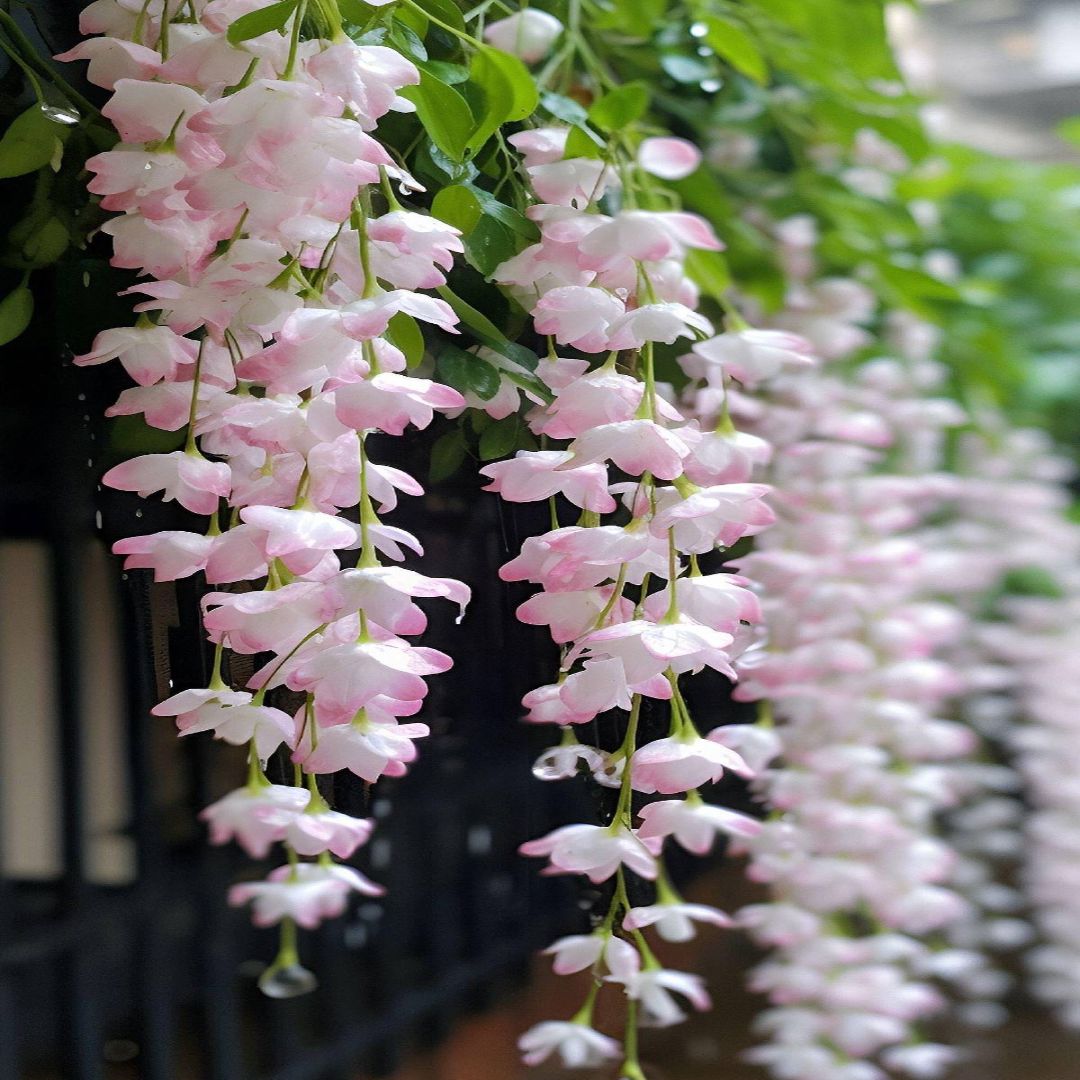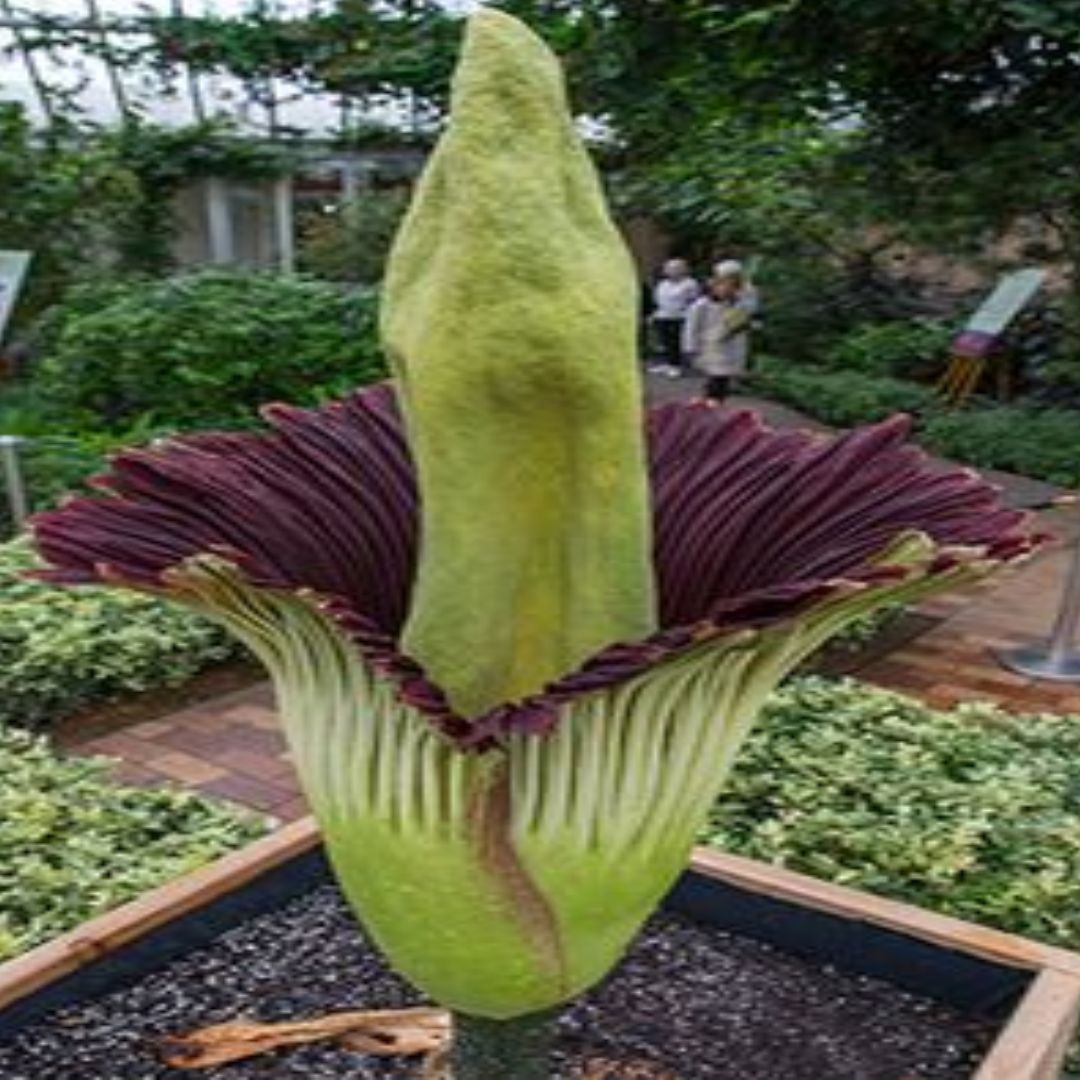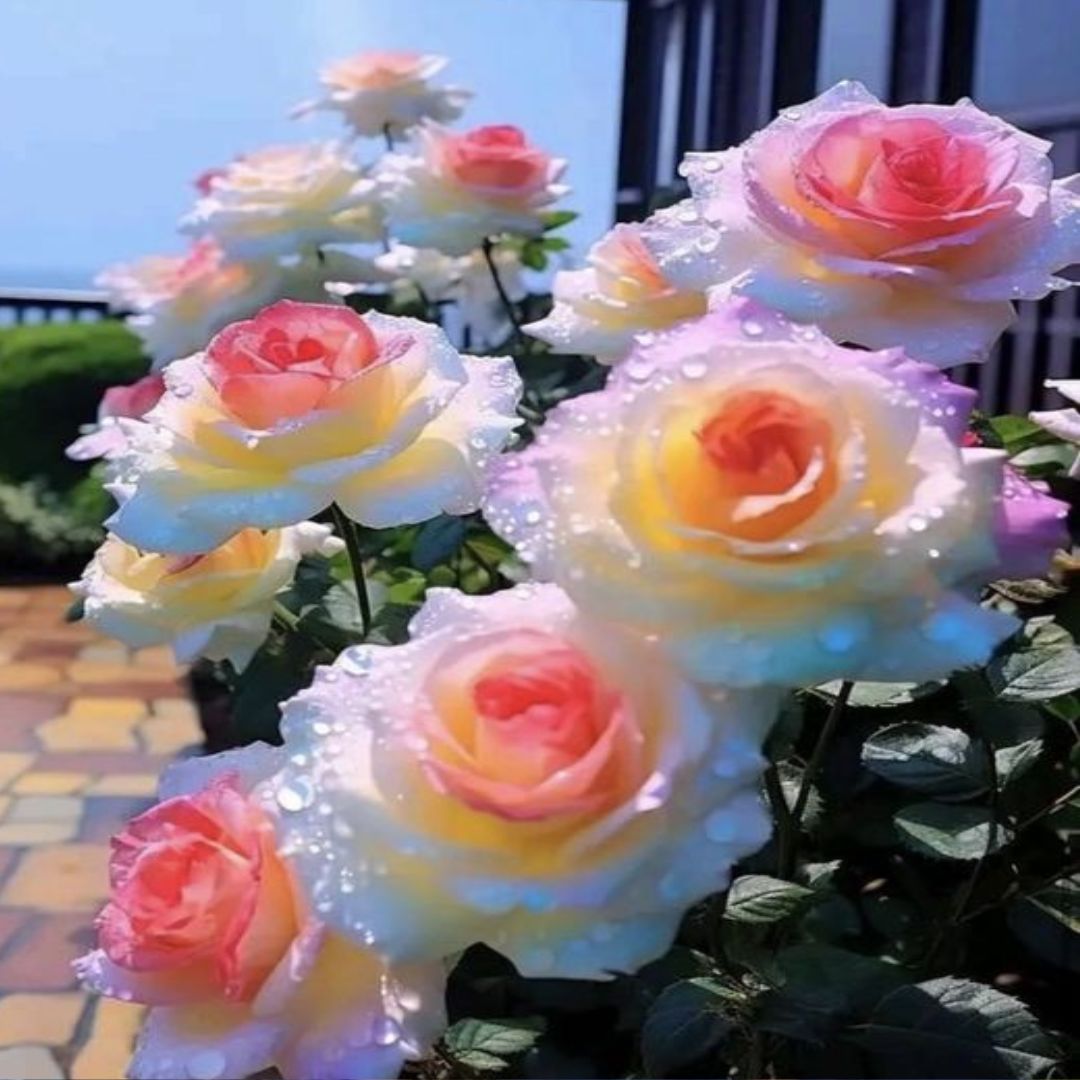The thick foliage in your garden is especially eye-pleasing, while splashes of color are always a nice addition. Your garden is truly lovely. Consider planting green flowers if you want to add more foliage. Given the rarity of green flowers, this is an excellent way to add some distinctive blooms to your peaceful setting. Fortunately, the selection is wide enough for you to pick your favorites, from subtle to eye-catching flowers.
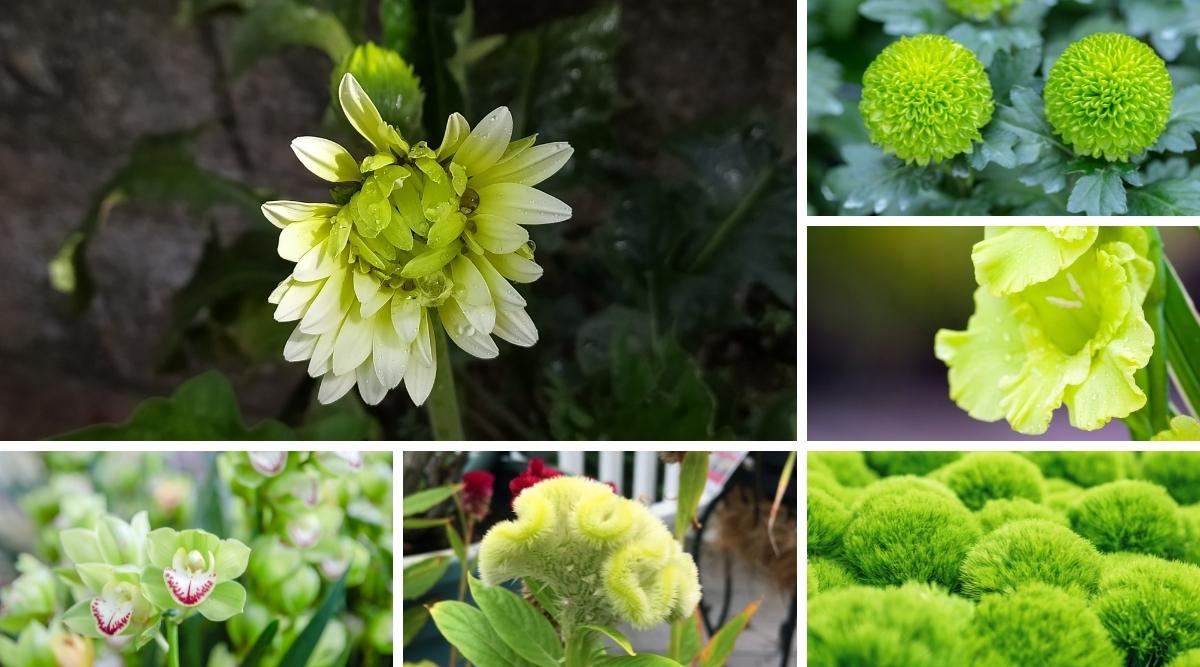
Excited to learn more? In this article, we’ve listed our favorite green flowers for you to look out for, and provided some basic tips on how to care for them so they can continue to thrive throughout the year (or years) that you may have them. Let’s get started!
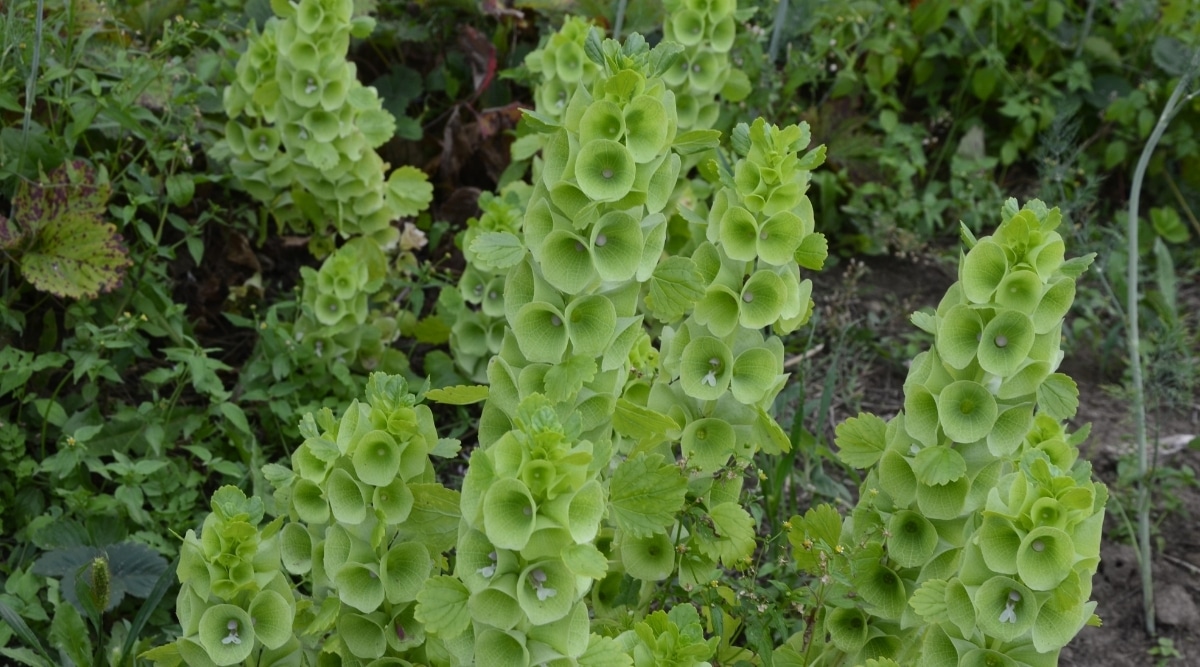
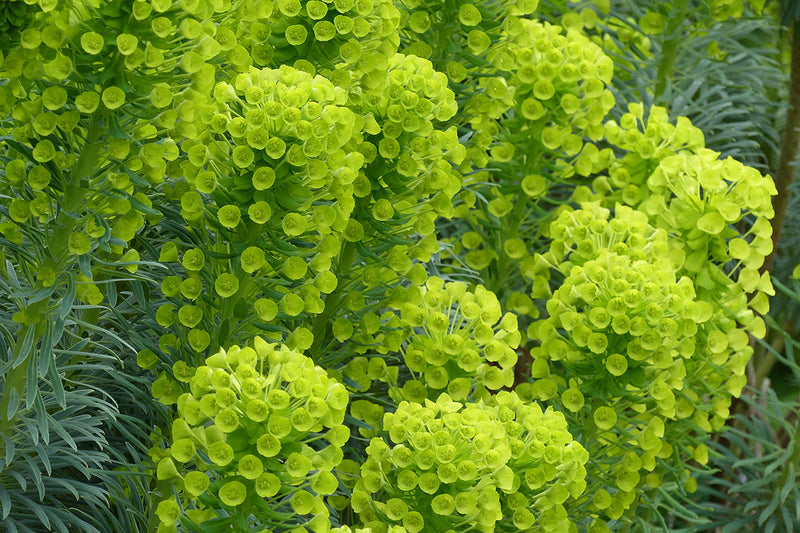
These green annuals grow to be 2-3 feet tall.
Scientific name: Moluccella laevis
Beautiful green flowers known as bells of Ireland bloom in long spires, with each flower resembling a bell. These are merely the calyces; the flowers are still green. The actual blossoms, which appear as tiny, fragrant white flowers, are hidden behind the opulent green bells. They are lovely when dried and are excellent for cutting and bringing inside.
It blooms from July through to September; they are an annual plant. The calyces stay attractive for a goodaount of time until around the late summer when they begin to turn beige. They also become papery before the seed comes in.
Bells of Ireland grow to be 2 to 3 feet tall, and spread 1 to 1.5 feet across. It enjoys full sun, but can tolerate light shade. It can also handle poor soils relatively well, provided that drainage is adequate. However, it much prefers loose, fertile, moderately moist soil.
You can plant this flower a little bit before the final frost, and warmer areas may even sow the seeds in the fall. However, know that the plants perform best in cooler summer climates. These flowers thrive best in USDA hardiness zones 2 through 11.
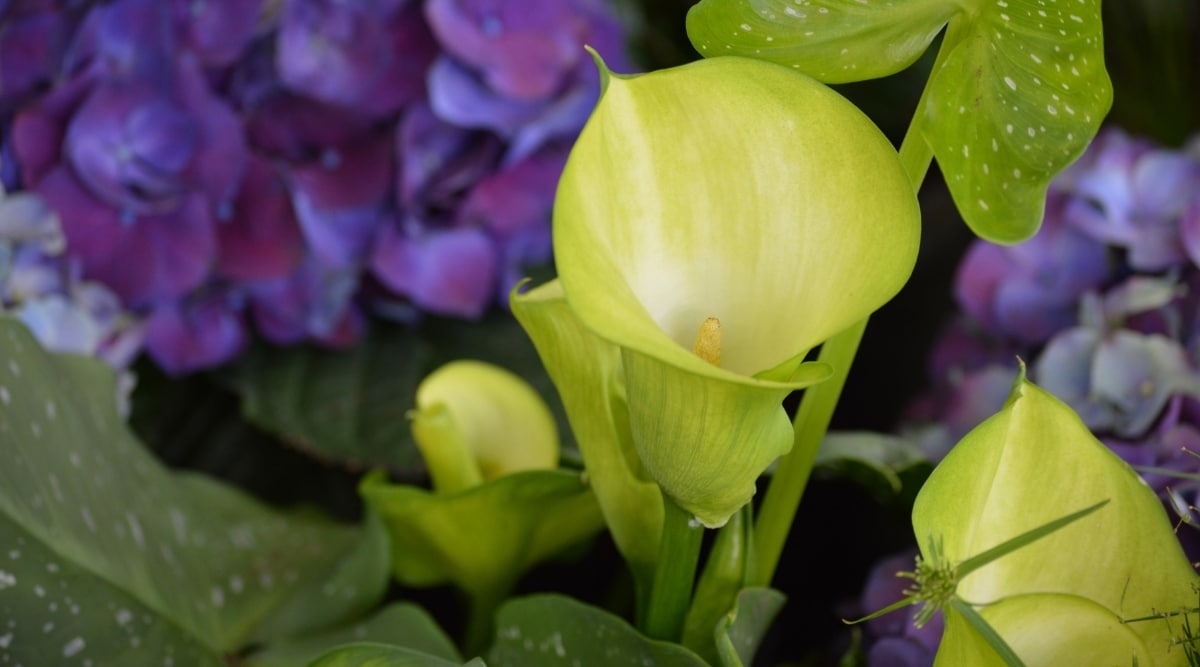
Though the most popular calla lily color is white, they also come in green.
Scientific name: Zantedeschia aethiopica
The iconic calla lily is best known to grow elegant, white flowers. They can come in red, or in rare cases, even black. Along the lines of rare colors, the Calla Lily can also come in green. Calla lilies are actually not true lilies and are more related to jack-in-the-pulpits. They grow directly from rhizomes and are, interestingly, technically stemless! These flowers are incredibly popular cut and are a favorite for wedding bouquets.
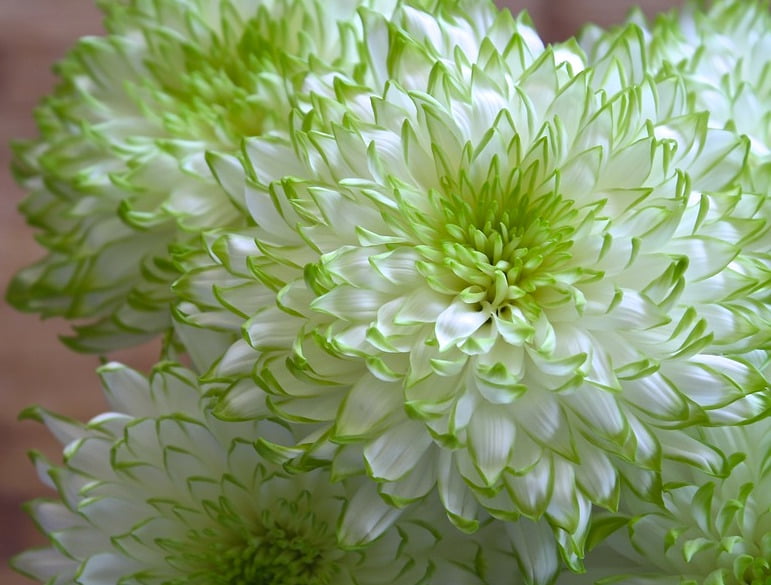
The bloom time for calla lilies is June through July. They do best in moist soil and will love the full sun. However, they also tolerate partial shade very well. It’s a good idea to leave them in partial shade if your summers are very warm. You can also choose to plant calla lilies in up to 12 inches of water, using mud. They’re popular for water gardens, so this may be something to keep in mind if you keep one!
You can opt to grow calla lilies indoors; simply bring them in before the first frost and ensure that they receive plenty of light. They will make beautiful house plants. It’s important to make sure that when growing calla lilies, you ensure that rhizome rot does not occur. Beyond this, they can be planted outdoors after the spring frosts. They grow best in USDA hardiness zones 8 through 10.
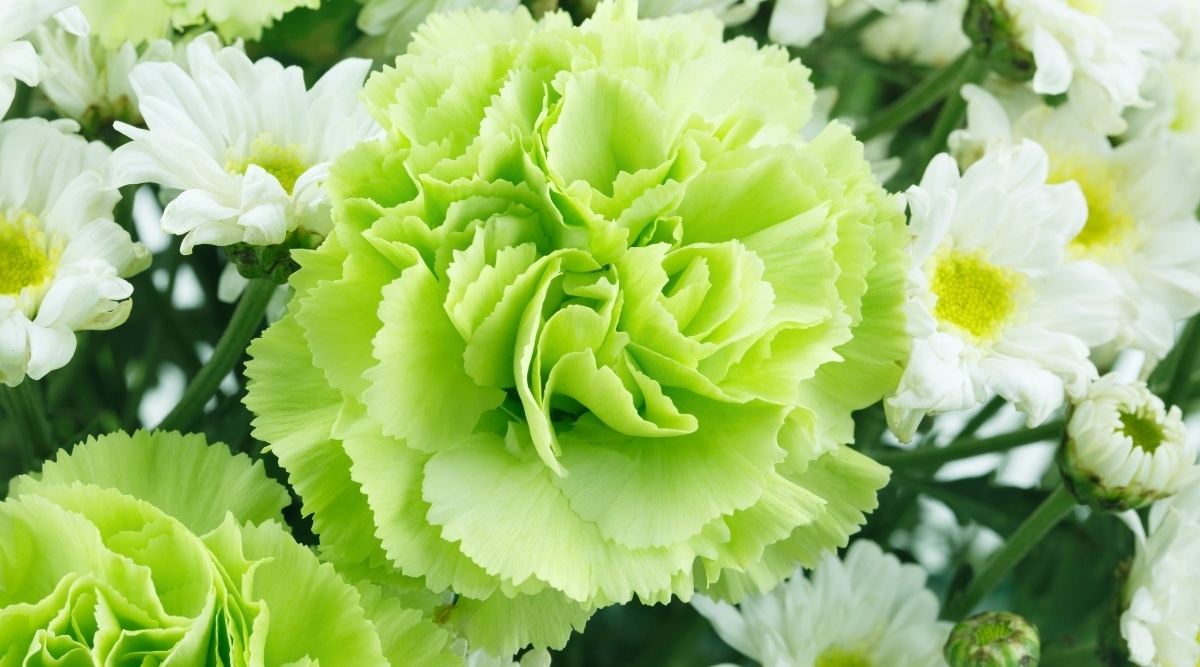

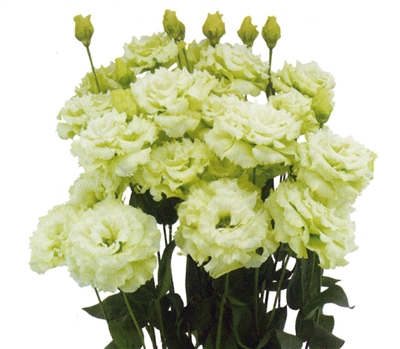
Green is one of the many colors these popular flowers come in.
Scientific name: Dianthus caryophyllus
Carnations are a favorite flower for many. Their ruffled petals are elegant and beautiful, and they come in a wide array of colors, including green. It is an herbaceous perennial that can grow anywhere from 6 inches to 5 feet tall, depending on the cultivar! They are popular as mother’s day gifts and make a great addition to any bouquet.
Carnations grow best in average soils that are moderately and evenly moist, provided that there is good drainage. You will get the best performance if you plant these flowers in loamy, organically rich soil; it will be a good thing to break out the compost!
They enjoy the full sun; this is what creates the best flowers. However, they also prefer cooler climates where the summers are not harsh. You can choose to grow this plant as an annual. Deadheading your carnations can encourage more blooms, so it’s a good idea to look into that if you want a longer bloom period.
Overall, the carnation is fairly low maintenance and will work fabulously in your home as cut flowers or when used for gifts. They are fairly resistant to disease and pests, though you should watch for crown rot when possible. Carnations grow best in USDA zones 5 through 9.
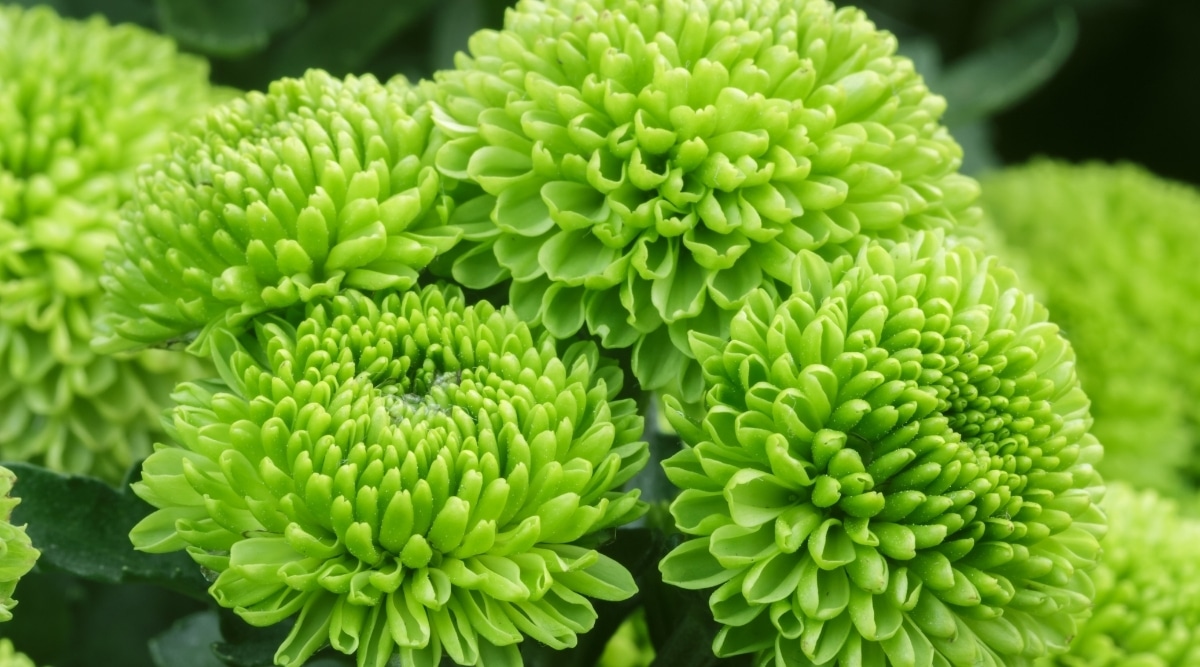
These flowers bloom in the autumn and are a favorite among many.

Scientific name: Chrysanthemum
Chrysanthemums are known to come in a range of colors despite their etymology, where “chrysos” is the Greek word for “gold.” It’s safe to say that they are a very popular flower, and so is the green color they sometimes come in. They are a fall favorite flower, being able to bloom from September until the frost.
Chrysanthemums enjoy the full sun; this helps them flower to their fullest potential, so ensure that they are getting the sunshine they need. However, they can tolerate partial shade if it gets very hot where you live. They will also need fertile, rich soil that is evenly and consistently moist. It’s worth noting that they grow a bit tall, ranging from 1.5 to 2 feet in height. They spreadaound 1 to 1.5 feet across.
If you plan to keep these plants, it is a good idea to cut them back down to 6 inches after the flowering period and to mulch the soil to give adequate protection from the winter. Still, this may not always ensure their survival. It may be better to use this plant as an annual instead and replace them as necessary. They grow best in USDA zones 5 through 9.

Among many other bright colors, cockscomb comes in bright green.
Scientific name: Celosia
Cockscomb is a gorgeous, vibrant plant that grows showy flowers reminiscent of a rooster’s comb– this is where they get their name. While they are traditionally red, it’s possible for them to come in green, as well. They are a great annual addition to the garden and will reseed enough to stay present year after year, even after the original plants are gone.
With regard to growth patterns, cockscomb can be full of surprises. Some varieties grow only a few inches tall, while some grow several feet tall! Cockscomb loves the sun and heat, and may even be drought tolerant in some cases. Giving them full sun allows them to grow to their best potential, though they can happily coexist in the shade of other plants as well. You should plant these flowers in rich soil that has good drainage.
Pinching back the first bloom can create more showy blooms for the cockscomb plant, so it’s a good idea to try this if you’d like more flowers. You can opt to grow the seedlings indoors upon purchase, though if you live somewhere warmer, it may be a good idea to plant them directly in the soil. Cockscomb is a perennial in USDA zones 10 through 11, it is an annual plant elsewhere.
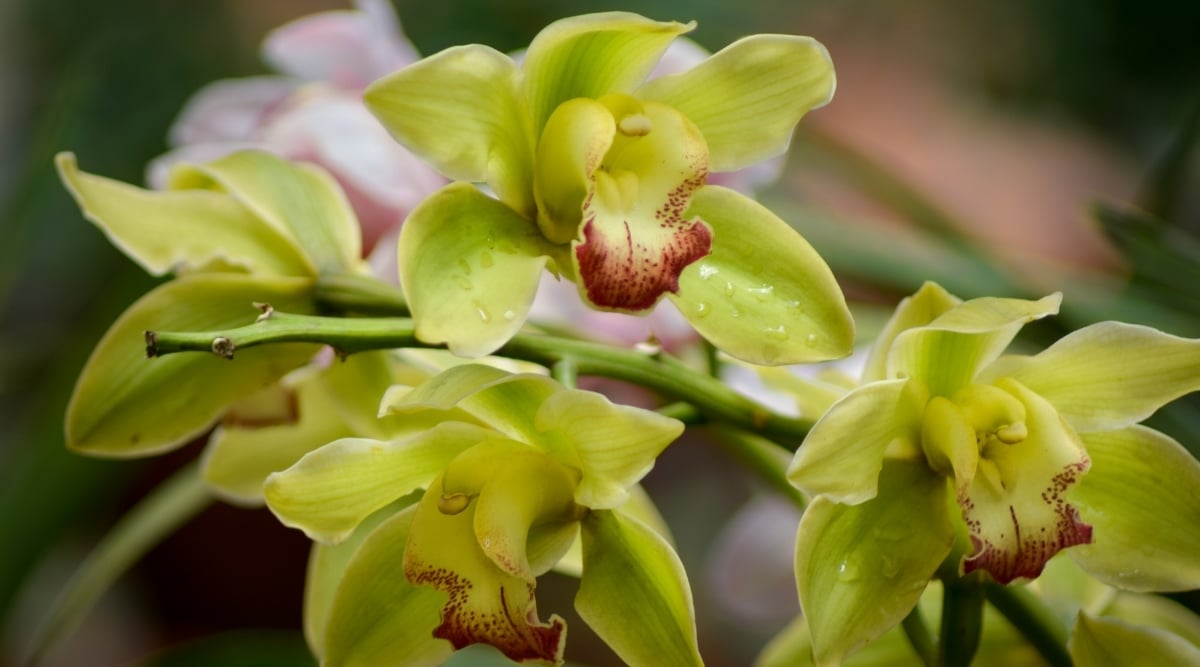
Tropical plants such as orchids do best in humid and hot climates.
Scientific name: Cymbidium
While some Orchids are blue flowers, the beautiful and showy, cymbidium orchids grow large flowers in sprays of many different colors, including green. They are a fair amount more cold-tolerant than most orchids are. The flowers themselves last anywhere from one to three months when cared for properly. Cymbidium orchids bloom from mid-autumn through mid-spring, so you have a long time to enjoy their blooms.
As your cymbidium orchids grow, they will appreciate dappled sunlight. When planted outdoors, they should never be in the direct light of the sun. You can opt to keep them in pots, sun them for a few hours, and move them back to shade in the afternoons. Keep in mind that if the plant does not have apple green leaves and they have leaves of a darker green shade, they probably won’t produce very good flowers. Grow these orchids in loamy humus. Loose, rich potting material should suit your purposes just fine.
When choosing to plant cymbidium orchids, it is best to start with a well-established, store-bought plant. Wait until after the flowering period to plant it in the ground or repot it. This is because it may take years for a new seedling to develop any flowers at all. These plants grow best in USDA zones 10 through 12.
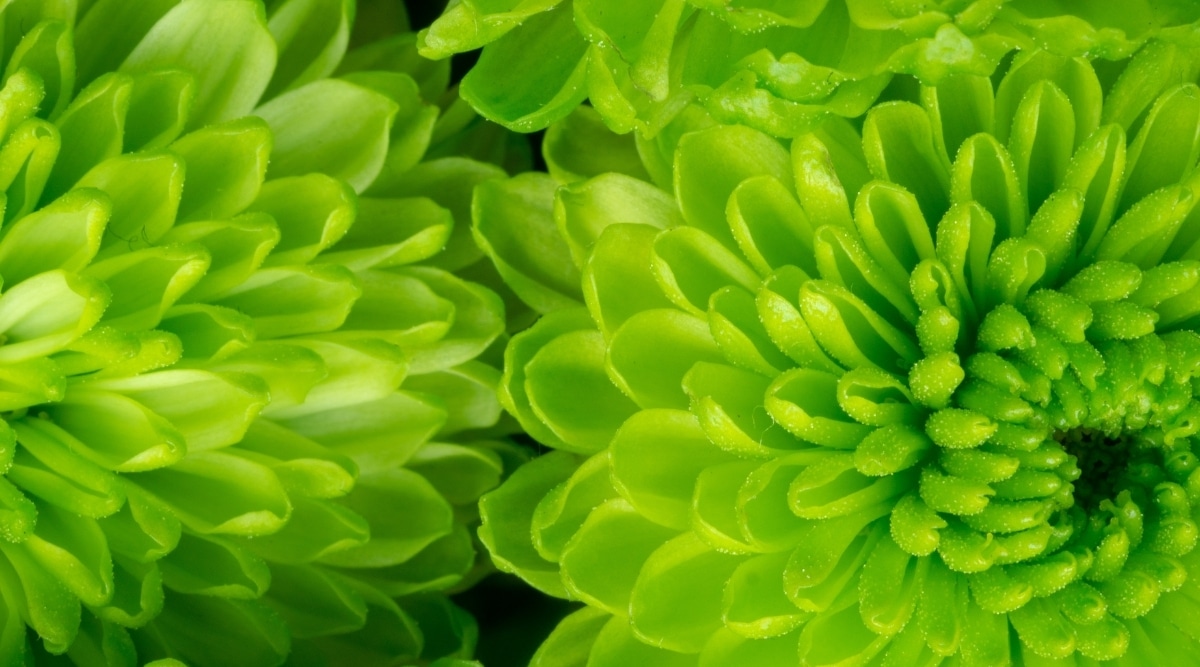
If you are a beginner gardener, dahlias are great flowers for your garden.
Scientific name: Dahlia
Dahlias are beautiful, multi-layered flowers that come in a rainbow of colors, including green. They are often used as cut flowers but have great use in the garden as well. It takes some care to get them to bloom their best, but the results are well worth it. It’s also worth mentioning that newer cultivars have been bred to make growing dahlias easier. It may be good to look into these if you are a beginner gardener.
Dahlias grow from tubers and are easily grown indoors in early spring to start them off right. After the frost clears you can then move them outdoors. They bloom from mid-summer up until the first frost. Lots of blooms will come from lots of sunlight, so be sure that your dahlias get enough, full sun is recommended. They love moist, loamy soil provided that it is well-drained. They will need one to two inches of water per week after they’ve sprouted.
Timing the planting of your new dahlias will be important, as they do not set up well in cold soil. Around 60 degrees Fahrenheit will suffice for the ground temperature. Saving the tubers for the winter will mean giving them a bit of humidity to prevent them from drying out. Dahlias grow best in USDA zones 7 through 10, given enough protection in the winter.
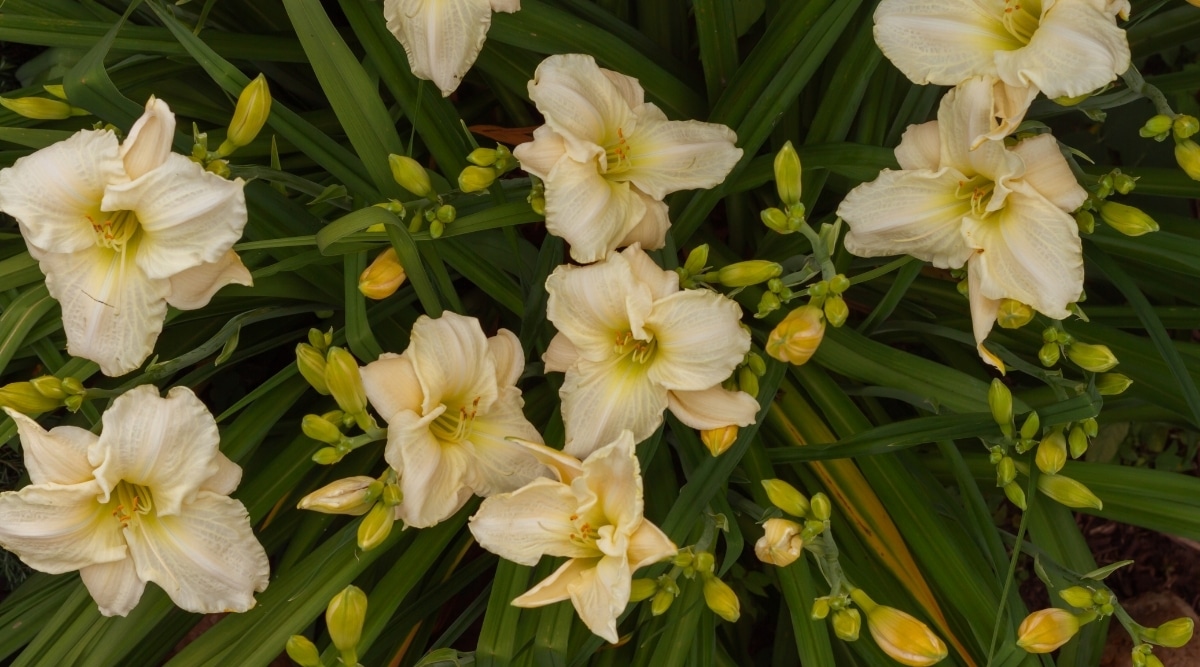
These popular flowers come in white, orange, red, and green, among a few other colors.
Scientific name: Hemerocallis
Daylilies are stunning perennials that come in a multitude of colors, including a lush, gorgeous green. They bloom throughout the spring up until late summer, so you have a goodaount of time to enjoy the flowers. They are easy to grow and will be a great choice for novice gardeners. These flowers are excellent for borders and edging, as well as cut to brighten up the home.
Depending on the cultivar, daylilies can grow anywhere from 8 inches to 5 feet tall, which is quite a large range! While they are tolerant of light shade, daylilies love the sun (as their name suggests) and will be happiest in a full sun environment. Fertile, medium-loamy soil is a good fit for these plants and will give them plenty of nutrients to grow up nicely. During the first growing season, they must be watered regularly. Straw mulch is a good idea to protect them during the winter, provided that the crown is not covered.
Pruning your plants to prevent seeding will allow more blooms to grow, so be sure to remove seed pods where necessary. You should also remove leaves that have yellowed during the growing season. Daylilies are happy in most environments and thrive best in USDA zones 3 through 10.
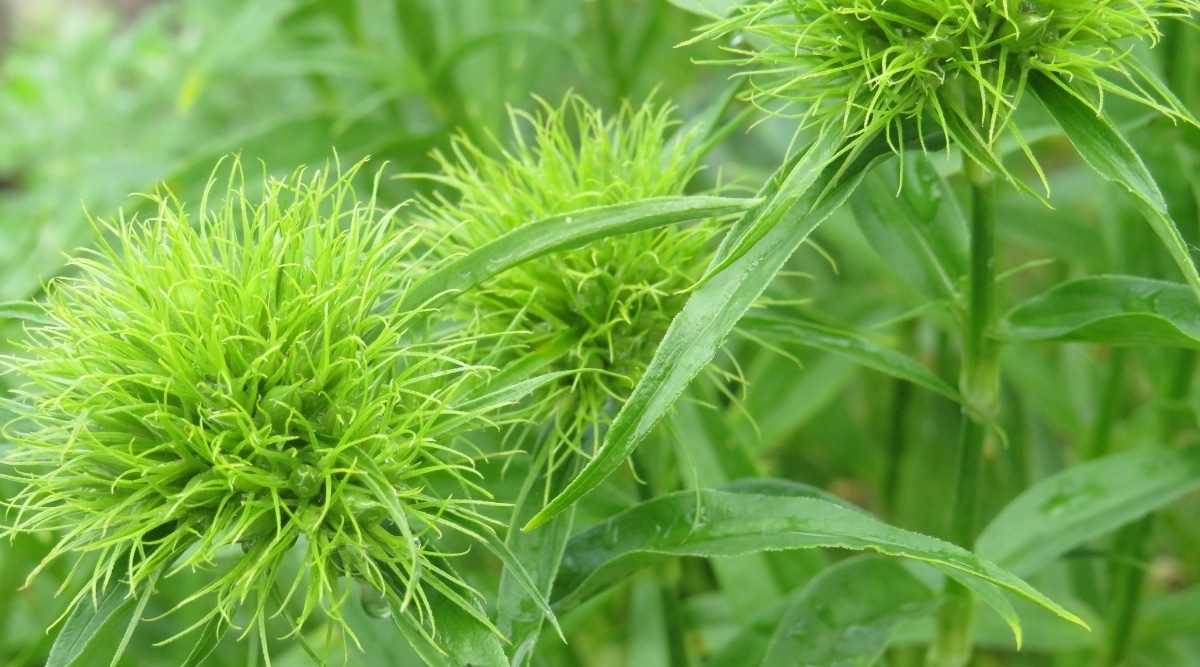
Adding dianthus to your garden is a good way to add green to the space.
Scientific name: Dianthus barbatus
Dianthus, of the ‘green ball’ variety, is a happy little plant that grows fluffy, green, pom pom-like flowers. These are round and fuzzy and will make a great statement in your garden. They grow from stiff stems that have glossy green leaves and are quite stunning in most applications. We think they do great as an interesting addition to bouquets as well!
These plants grow 10 to 14 inches tall and spread 8 to 12 inches wide. They enjoy the full sun, so be sure to give them a spot in the garden that gets a lot of sunlight. However, it may be a good idea to let them have shade in the afternoons if you live in a place that gets very warm summers. They enjoy organically rich soils that are well-drained; it may be good to break out the compost to ensure the best growth and the most blooms. They make a great option for borders, though they can also be stunning when planted in containers.
When planting green ball dianthus, you can opt to plant the seeds in the springtime to expect flowers the next year. It’s important to ensure good drainage in the soil to prevent crown rot and rust. Pesticide may also be necessary to deter slugs and similar pests. This plant grows best in USDA zones 3 through 9.
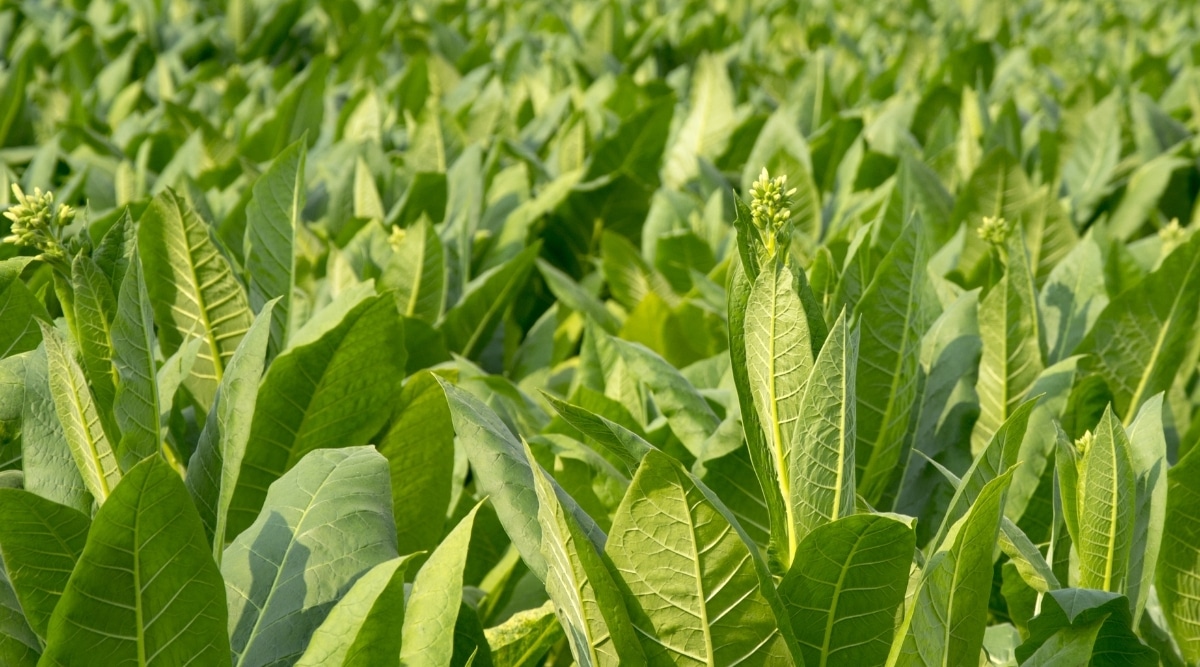
If you are looking for an aromatic green flowering plant, flowering tobacco is an excellent option.
Scientific name: Nicotiana alata
Flowering tobacco is a relative of true tobacco, though this plant is grown for its flowers which produce an attractive fragrance. They are capable of blooming very nice, green flowers. They make a great addition to cottage gardens for their rustic aesthetic. Flowering Tobacco comes in a large variety of sizes, ranging from small ones that are suitable for containers to ones that grow up to 15 feet tall, better suited for staking towards the back of the garden.
Flowering tobacco blooms in the summer and fall. They are very easy to grow as long as you give them moist, well-drained soil. Rich soil means a lot of blooms, so using compost is an excellent idea. While they will be happiest in consistent moisture, flowering tobacco is capable of handling a little bit of drought, which just makes it easier to maintain them. Full sun is recommended for this plant, though some varieties will also be happy in partial shade.
Given that tobacco plants are poisonous, these plants should be placed somewhere that kids and pets cannot get to. On the bright side, they are virtually pest-free for this reason as well. Flowering tobacco grows best in USDA zones 10 through 11.
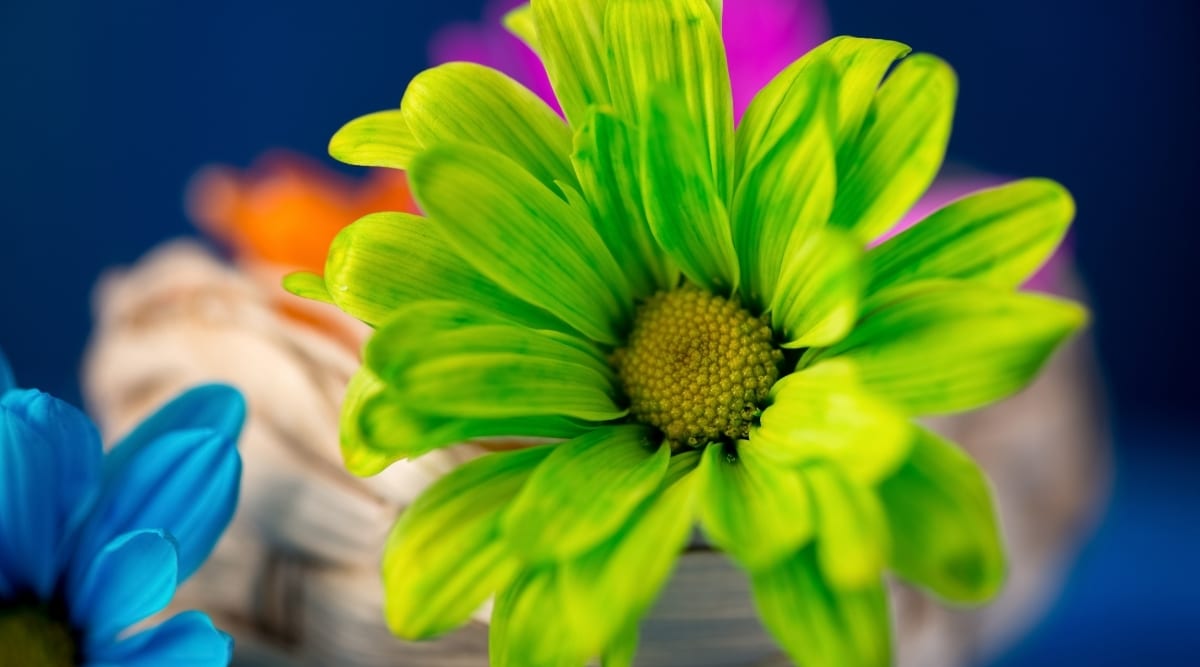
These sunshiny blooms come in a variety of colors, including green.
Scientific name: Gerbera
The gerbera daisy is one of the most cheerful flowers out there. They have ray-like petals surrounding a round center, containing tiny flowers that are either black or green. They are perfect as a cut flower, though they are sure to brighten up any spot of the garden you may choose to put them in.
You should give your gerberas full sun to ensure the best blooms. However, they will not enjoy excessively hot conditions. If you live somewhere warm, it’s a good idea to plant them where there is shade in the afternoons. Gerbera daisies love moist soil that is well-drained and will prefer either a neutral or acidic soil pH.
They will need regular watering; frequent watering may be necessary during the establishment period. Take care not to water them too much during the wintertime, as they do not need much to be revived come the spring.
Gerbera daisies should be planted in the springtime after the threat of frost is no longer there. You can choose to grow them from seeds and find that they establish themselves quite well in a moderate amount of time. They also can be grown from starts. Expect to wait 3 to 4 months for the first blooms to appear; they will continue blooming well through the summertime. They grow best in USDA zones 8 through 10.
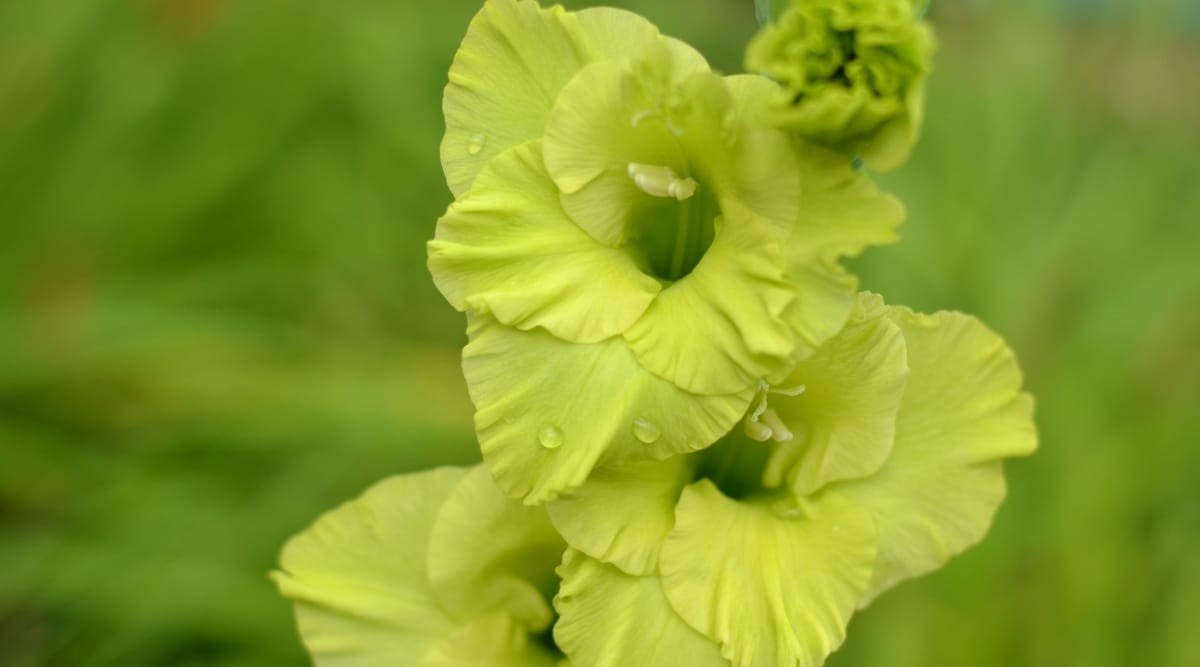
These beautiful flowers look stunning in a garden and in a vase.
Scientific name: Gladiolus
The gladiolus is a spectacular plant that grows charming flowers in tall spires that can get up to 2 to 5 feet tall. They come in a wide array of colors, including green, so they may just be the thing to add some verdant beauty to your garden! The trumpet-shaped flowers are a delightful sight and add visual interest to cut arrangements.
Gladiolus plants are happiest when they have full sun, though it may be a good idea to give them shade if you live somewhere that is particularly hot. Partial shade in the afternoons can be good for this plant, just bear in mind that full sun is what makes it bloom best. Gladiolus plants enjoy soil with a sandy, loamy quality, having a relatively neutral pH. They still grow fine in other types of soil as long as it is well-drained.
With regard to water needs, water gladiolus plants often when they are establishing themselves. Beyond that, when well-established, water them weekly. You will need to stake these flowers to keep them looking great and standing tall. Plant your gladioli in good temperatures; around 60 degrees Fahrenheit in the nighttime is good to aim for. Gladiolus plants grow best in USDA zones 7 through 10.
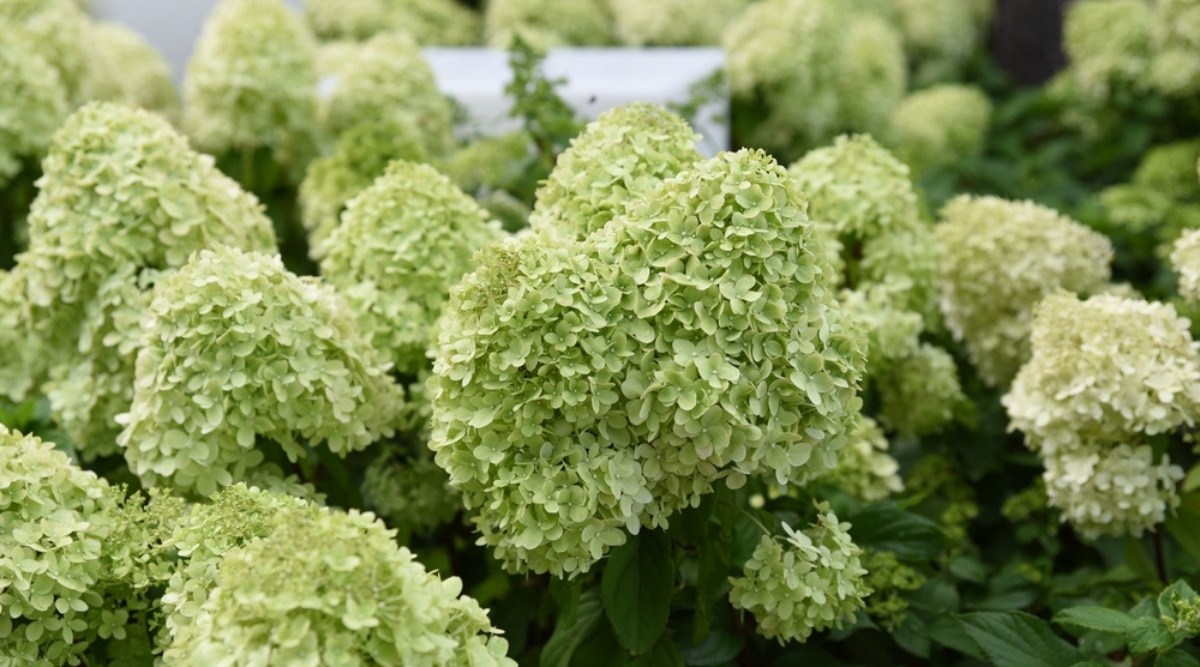
One of the most popular garden plants that have green flowers is hydrangeas.
Scientific name: Hydrangea macrophylla
Hydrangeas are a popular garden plant. These large shrubs grow very showy clusters of flowers that come in a wide range of colors, including green. When mature, hydrangea shrubs can grow up to 15 feet. They grow quite fast and will average around 2 feet of growth each year.
Give your hydrangeas a goodaount of sunlight. They will be satisfied in partially shaded areas as long as they get enough sun in the mornings. They also thrive in full sun, but you should be sure to give them plenty of water on particularly hot days.
Hydrangeas are happy in most different types of soil, though you should ensure that it is well-drained. Watering should be done very deeply at least once a week, especially if it has not rained that week. This is even more important during hotter summer days, but it’s important not to overwater either.
Pruning your hydrangeas will not be very necessary, but you can still do it if you’d like to minimize the size of the shrub. Hydrangeas grow best in milder temperatures and will need shelter from the elements during the wintertime. They also enjoy high amounts of humidity and thus thrive well in coastal areas. Hydrangeas are happiest when they are planted in USDA zones 5 through 9.
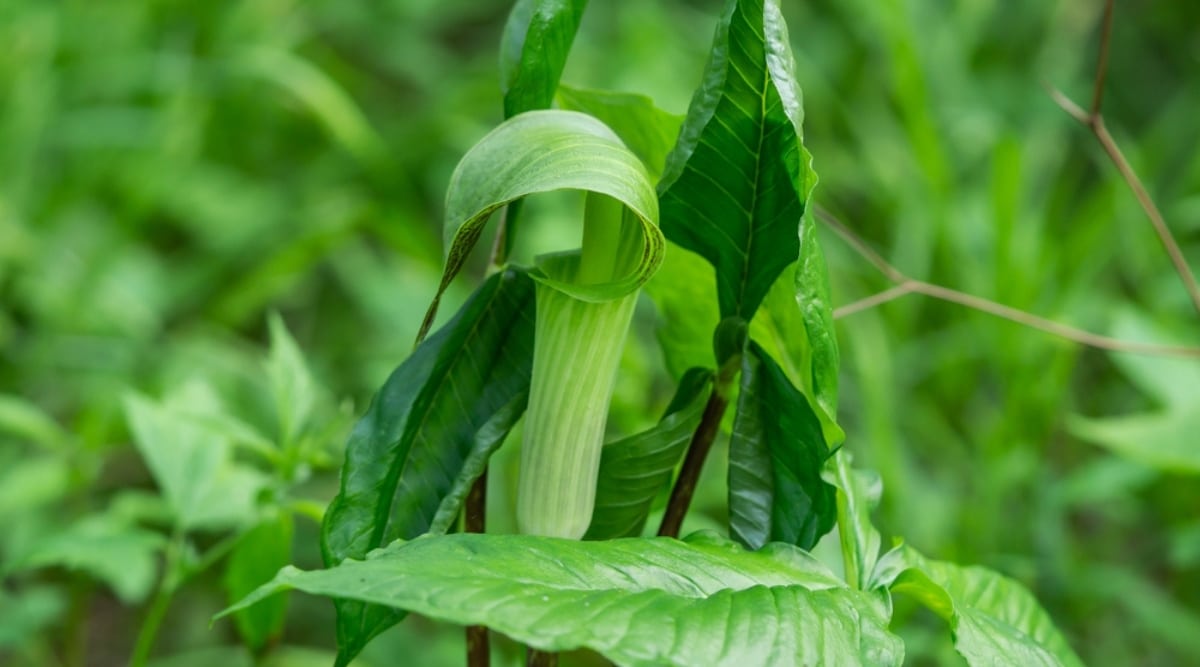
These wildflowers grow very well in shaded, moist gardens.
Scientific name: Arisaema triphyllum
The jack-in-the-pulpit is an interesting plant that grows even more interesting flowers. Truth be told, the structure known as the flowers is a stalk, or spadix, that grows within a hooded cup, called a spathe. The actual flowers of this plant are tiny, lining the spadix. Regardless of the true nature of these flowers, the jack-in-the-pulpit makes a great ornamental plant suitable for any garden that needs extra greenery.
Jack-in-the-pulpit plants are fairly easy to grow as long as you have the right conditions. They enjoy the shade, as this is where they grow wild in more wooded areas. As for soil, jack-in-the-pulpit will be happy even in poorly-drained soil. They prefer moist, and sometimes even wet, soil conditions. This makes them a great addition to rain or shade gardens.
You can opt to use ferns as companion plants, as this is a striking combination. Remember that jack-in-the-pulpit will enjoy organically rich soil, so it is good to mix compost in with the soil prior to planting.
You can choose to mulch jack-in-the-pulpit plants with organic mulch, and then replace it every spring. You will find that jack-in-the-pulpit plants will not be prone to pests or disease, but might be bothered by slugs every now and again. Using traps and slug bait should deter these pests. Jack-in-the-pulpit grows best in USDA zones 4 through 9.
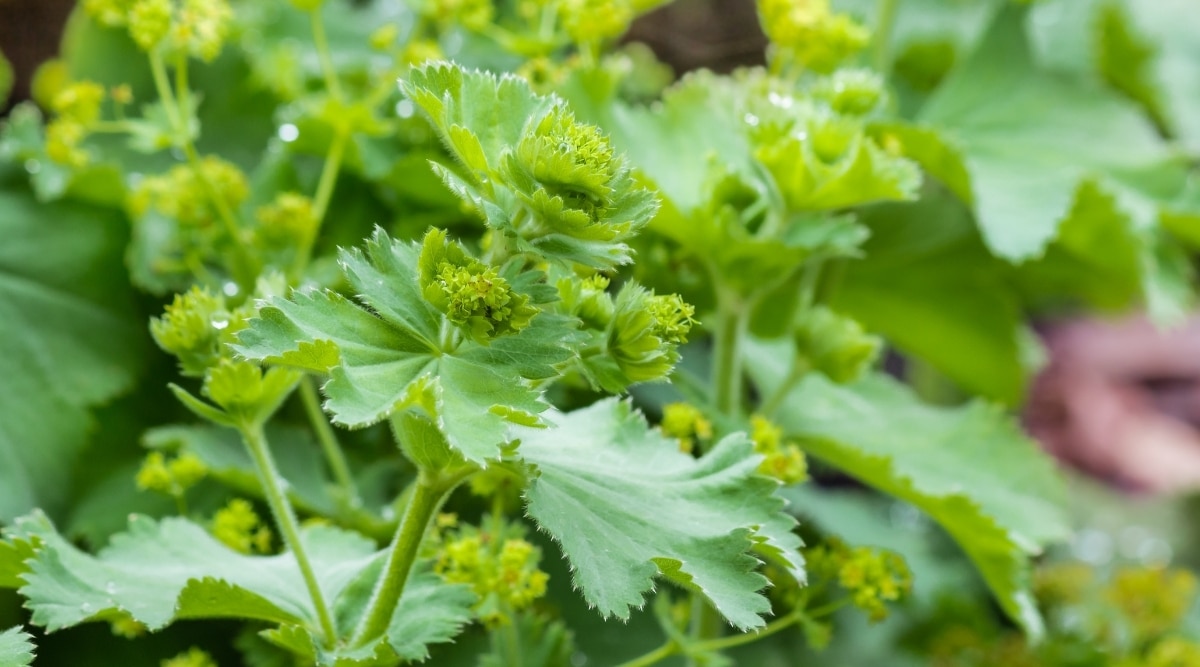
If you are looking for an easy-to-maintain green flowering plant, lady’s mantle is the way to go.
Scientific name: Alchemilla
Lady’s mantle is a plant that will add gorgeous, rustic charm to any cottage garden. It’s an herbaceous perennial that has few needs in terms of maintenance and produces pretty, light green flowers. You can opt to use them as ground cover in areas that need it. Interestingly, lady’s mantle is also used to make cosmetics such as soaps and lotions.
Lady’s mantle enjoys both the full sun and the part shade, though they will flower more with more sunlight. Hot climates will need you to give this plant at least partial shade in the afternoons, though. With regard to soil, lady’s mantle is good in pretty much any kind of soil, provided that the pH is neutral to slightly acidic.
It will be easy to keep this plant happy when watering them, as they can be drought-tolerant once they have established themselves well enough. However, full sun conditions will require you to water them regularly to prevent them from drying out. Fertilizer is hardly necessary; only fertilize if soil conditions are poor.
Keep in mind that lady’s mantle will self-seed quite prodigiously and will probably need to be kept in check unless you want them to take over your garden! You can choose to move plants into containers to make control easier. Lady’s mantle grows best in USDA zones 3 through 8.
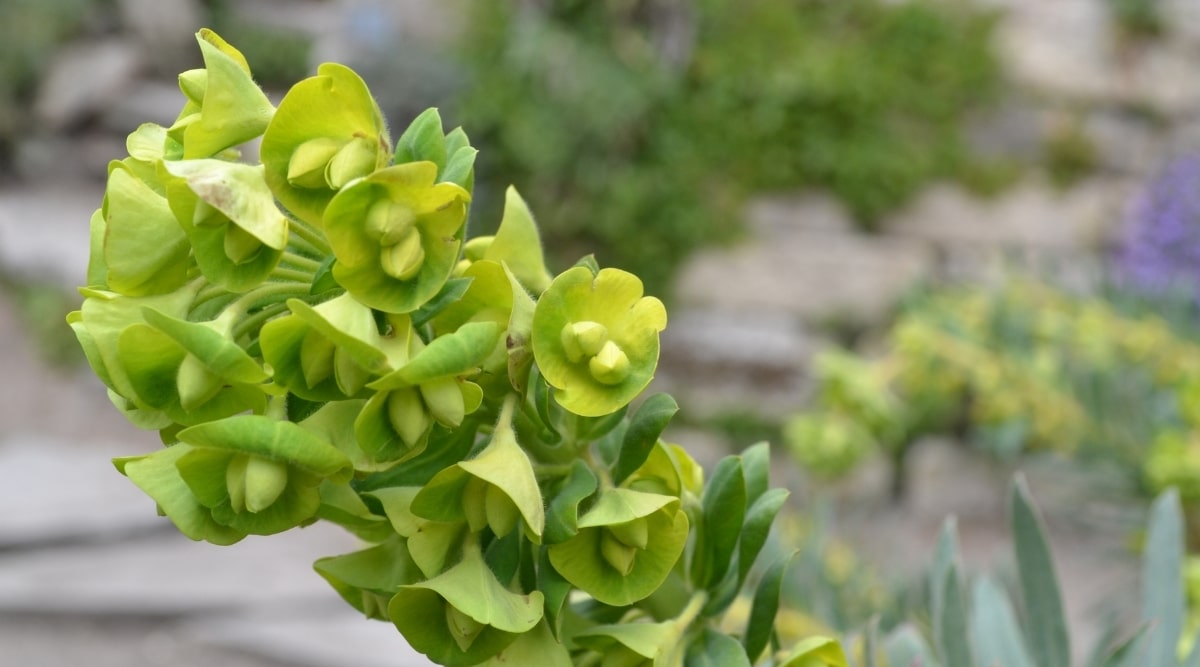
These flowers are drought tolerant and do well in hardiness zones 7-10.
Scientific name: Euphorbia characias
Mediterranean spurge is an eye-catching evergreen sub-shrub that will flower in light green for many months of the year. They grow anywhere from 3 to 4 feet tall and will spreadaound the same amount wide. You will enjoy this plant most as a focus for beds and borders, and they will do well in rock gardens or Mediterranean-style gardens too.
This plant is very easy to take care of past the establishing period. Once well-established, they become fairly low maintenance and can take care of themselves for the most part. They will prefer the full sun, thriving well in the heat.
Dry to medium soils are a good choice for Mediterranean spurge, as long as they are well-drained. They are quite drought-tolerant, though it will be a good idea to give them some more water in particularly dry conditions, such as arid summers. Humid summers are not good for this plant either, though, so bear this in mind when selecting it for your garden.
Water this plant when the soil is dry to the touch, and try to penetrate the first few inches of soil. They may do well with some fertilizer, so choose a good organic one to give them the incentive to grow. Mediterranean spurge grows best in USDA zones 7 through 10.
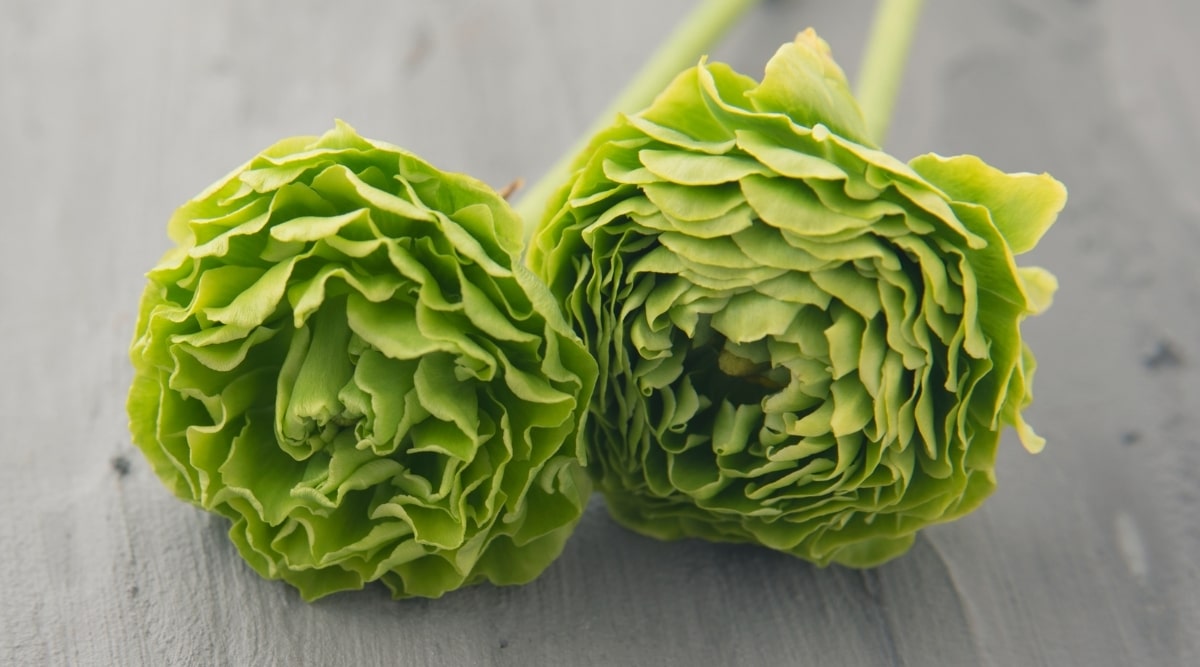
Popular among brides, the ranunculus comes in bright, beautiful green as well as the well-loved white.
Scientific name: Ranunculus
The ranunculus is a favorite flower for weddings because of its romantic look: multi-layered, ruffly petals coming in an array of colors, including green. They are a great addition to any bouquet of flowers, but make an especially stunning display in gardens, too. They are fairly easy to grow and will be a wonderful, lush addition to your beds.
You should give your ranunculi a lot of sunlight. Full sun, with sunlight hitting them for around 6 hours a day, is a good idea. Ranunculi prefer sandy, loamy soil that has a slightly acidic pH. Ensure that the soil is well-drained to prevent problems later down the line. Be sure to water the bulbs well if you are planting them, but try to hold off on watering them too much, until growth begins to show.
Once your plants have established themselves, we find that they enjoy moist soil. You can create this condition for them by watering once the top layer of soil has begun to dry. Fertilizing your ranunculi may be a good idea; try to do this bi-weekly with a good, organic fertilizer. Ranunculus flowers grow best in USDA zones 8 through 10, and will prefer cool spring weather.
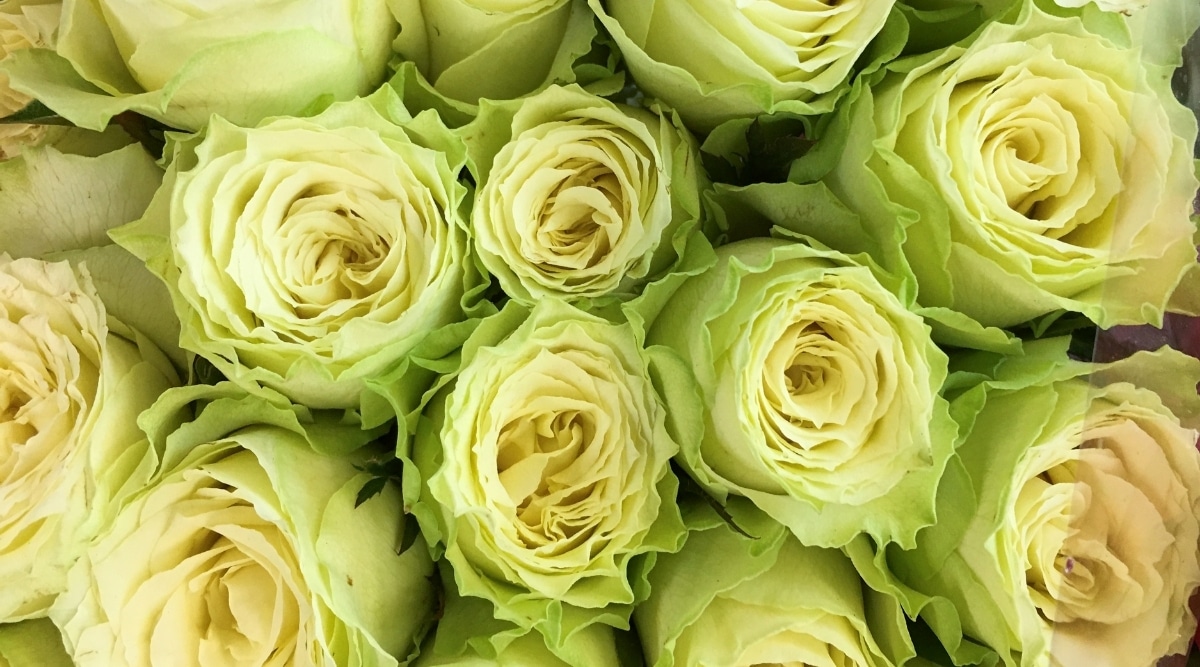
The rose is most often thought to be red, yellow, white, and orange, but it can also come in green.
Scientific name: Rosa chinensis viridiflora
Roses are arguably one of the most popular flowers in the world, being a huge favorite for many different applications. It’s interesting to note that in the rainbow of colors that roses come in, green is one of those colors too! Though do keep in mind that they are slightly different from how we know roses to be. They do not grow petals and instead grow green sepals. They are also known as a𝓈ℯ𝓍ual flowers, meaning they do not produce pollen, nor rose hips.
Green roses grow to a height of 3 to 4 feet. They do not really differ in care from other rose varieties, as unique as they may be. It’s a good idea to give your green roses lots of sunlight; around 4 to 6 hours a day should suffice. Being sun-loving, green roses will be tolerant to some amount of drought. They enjoy most types of soil as long as it is well-drained.
You should fertilize these roses in the springtime. Pruning them should be done mostly in the fall, where you can then shape the plant to be the height and width you wish. Green roses are a perennial in USDA zones 5 through 11.
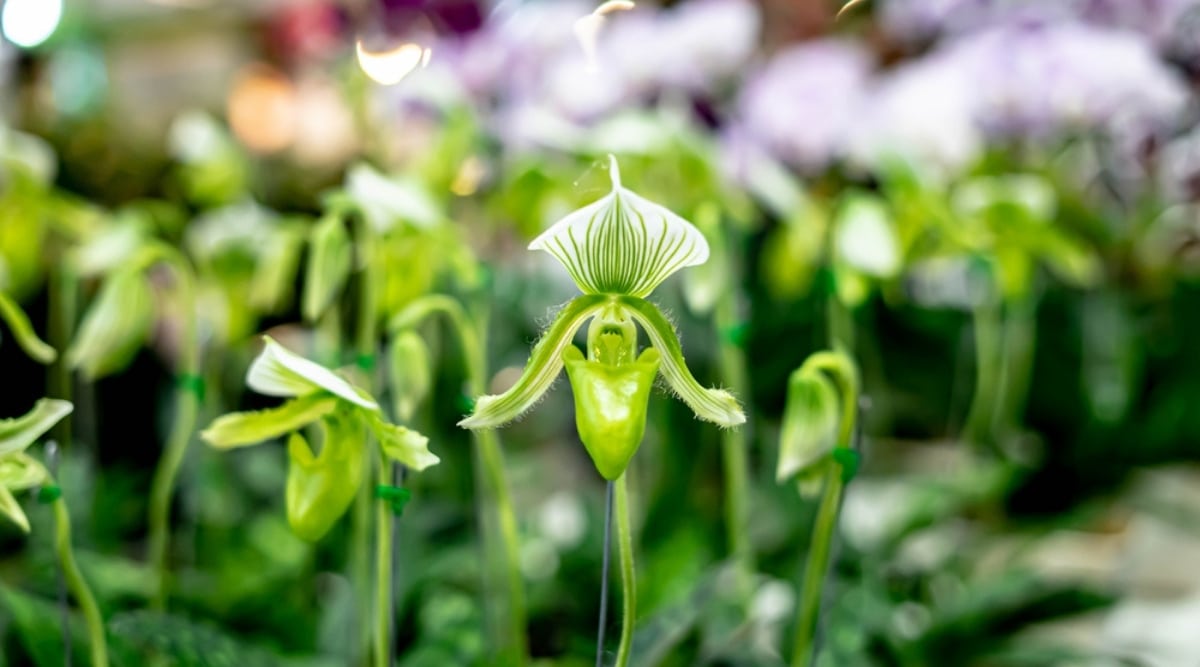
These tropical plants are popular indoor plants, but they can also grow well outdoors in the right conditions.
Scientific name: Cypripedium reginae
The tropical lady’s slipper orchid is a fascinating indoor plant that thrives in places like conservatories or greenhouses. It boasts unique slipper-shaped blooms that are green in color, making it a great choice for those seeking unusual, verdant flowers. These blooms last for a few weeks each year, so it’s important to cherish your time with them!
It’s worth noting that orchids are sensitive to dry air, which can be detrimental to their health. To keep your orchids happy, mist them regularly and maintain a humidity level of around 50%. They require moderate to bright light, but should be kept away from direct sunlight. Indirect sunlight is ideal for these orchids to bloom.
When planting tropical lady’s slipper orchids, use a loose medium that allows for proper aeration around the roots. Repotting every few years is recommended. Keep the soil evenly moist at all times but avoid overwatering to prevent root rot.
During the growing season, you can fertilize these plants with a good organic orchid fertilizer twice a month. Propagation by division is also possible. Tropical lady’s slipper orchids grow best in USDA zones 3 through 7.

Green is one of the many colors tulips come in, with pink, white, yellow, and red being a few others.
Scientific name: Tulipa
Tulips are one of the most popular flowers worldwide, known for their beauty and the wide range of colors they come in. Interestingly, tulips can also be green, which adds a unique and subtle beauty to any garden. They are sturdy plants that can be easily grown by novice gardeners, and should be planted in the fall for a late spring bloom.
Green tulips can grow up to 15 inches tall, and look especially beautiful when combined with other flowers as companion plants. They thrive in full sun but can handle some afternoon shade in hotter climates. To ensure a good bloom, plant tulips in rich, fertile soil mixed with compost. Keep the beds moderately moist, and ensure good drainage to prevent rot.
Cut green tulips make for a whimsical addition to any bouquet. Plant them in the fall for a springtime bloom. Tulips grow best in USDA hardiness zones 3 through 8.
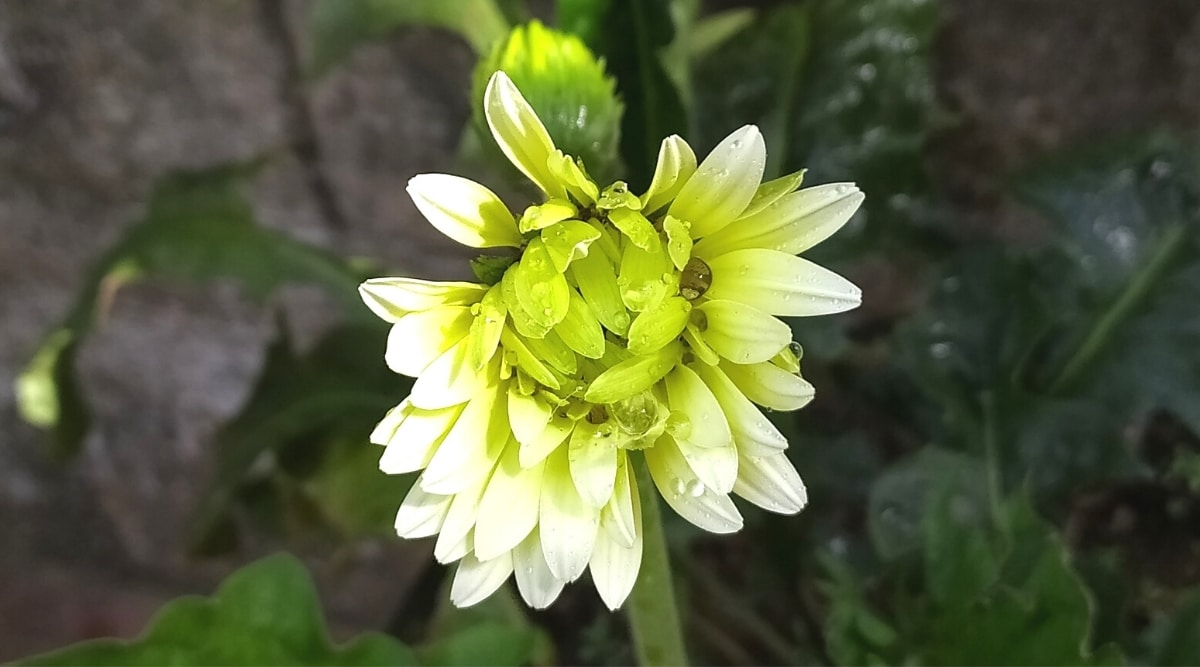
Zinnias are very easy to grow and can add a pop of green to any garden.
Scientific name: Zinnia elegans
The final green flower on our list is the zinnia, which is not only beautiful but also easy to grow. Zinnias come in a wide variety of colors, including green, and they thrive in warm weather. They will provide splendid blooms for you to enjoy from late spring through to the first frost of the year. It’s important to note that they are annuals, so enjoy them while you can!
Zinnias love the sun, so be sure to give them a spot that gets a lot of sunshine. Not only will this give you amazing blooms throughout the flowering period, but it also helps to keep mold and mildew away since the leaves are drier in the sun. They are easy to grow and not picky about where they are planted. They only require soil that has good drainage to prevent rot, and they can even grow in poor soils. Adding compost can enrich the soil if desired.
What’s truly fantastic about zinnias is that they will bloom regardless of how hot it gets. You can occasionally feed them with fertilizer to produce more blooms, but it’s not always necessary. They are happiest when grown in USDA hardiness zones 2 through 11.
We hope that this article on 21 green flowers has provided you with the insight you need to begin planting these fabulous flowers in your garden. Enjoy their lovely green hues and let them be a sight for sore eyes! Cutting them to bring some foliage into your home is also a great idea. If there’s a flower we missed or if you have any questions, let us know in the comments section below. We’d also love to know your favorite green flower!

